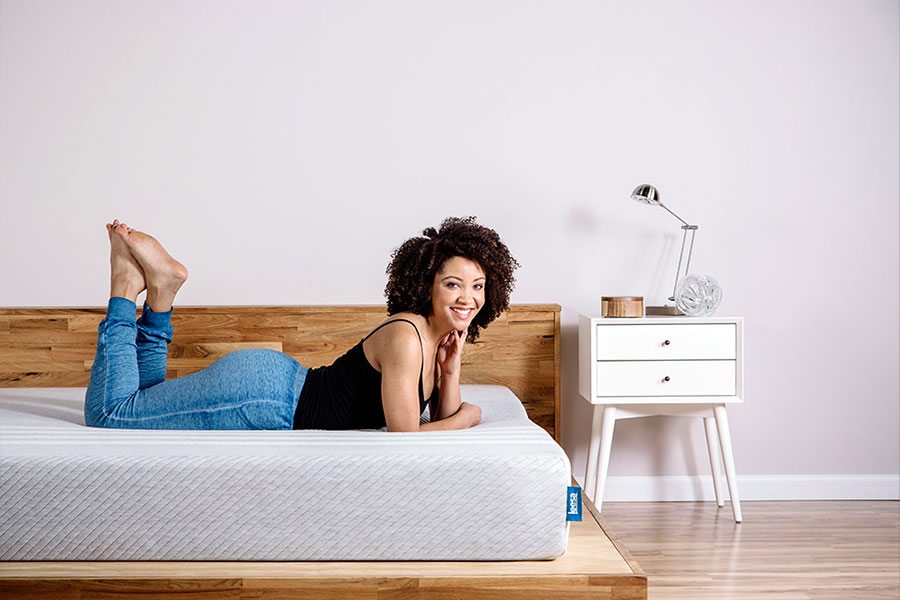You spend around a third of your life in bed, so make sure your mattress meets your needs.
Research by the Sleep Council reveals that sleeping on an uncomfortable bed could rob you of up to an hour’s sleep every night and leave you fatigued. Often the mattress is the problem, but the prospect of choosing a new one can feel just as exhausting. Our tips will guide you through the steps.

The Verona bedstead by Warren Evans is paired with the Pure 6000 pocket-sprung mattress, which has hand-tufted fillers made from bonded cotton, lambswool, silk and cashmere. Priced from £560 for a single.
Out of your comfort zone
Do you or your partner wake up with stiffness or aches and pains? Are you sleeping as well as you did a year ago? Have you had a better night’s sleep in a bed other than yours? If the answer to any of these questions is yes, then it might be time to invest in a new mattress.
Look out for visual clues too. “If your mattress feels lumpy, dips in the middle or shows signs of wear and tear then it usually needs to be replaced,” says Dave Gibson, sleep expert at Warren Evans.

Handmade in Wiltshire, the Penselwood pocket-sprung mattress from Willow & Hall is priced from £362 and comes with a 10-year guarantee.
Base + mattress = a great team
It’s always best to buy a base and mattress together, as they’re designed and manufactured to complement one another.
“If you were to purchase a new mattress for use on an old divan base for example, its worn and tired sprung-divan system could provide a reduced level of support and could result in premature wear to the new mattress, which in turn would invalidate any guarantee,” explains Chris Ward, group marketing director at Hypnos.
You may also find that the new mattress doesn’t fit on the old divan snugly, which can lead to movement and eventual damage – as well as uncomfortable nights for you.
It’s important to note that whilst your mattress may show visible signs of wear and tear, the base may not. However, both will have endured the same amount of strain and pressure, so it’s worth considering a complete change when it’s time for a new mattress.

Hästens’ Auroria features a 13cm Bonnell spring system in its base combined with a 15cm pocket spring in the upper mattress, wrapped in layers of natural materials. Priced £13,490.
The price of a good night’s sleep
Always shop for the best value rather than the lowest price: as a rule of thumb, you generally get what you pay for. “If I were to spend less than £100 on a mattress, I’d want to know why it only costs this. For example, what fillings have been used in it? Are they high-quality and natural, meaning they help to regulate body temperature, keeping you cool at night and stopping you from overheating? What quantities of natural materials have been used in it and have they been ethically sourced?” says Chris.
“You often find that cheaper mattresses tend to use synthetic and lighter fillings, meaning you might need to replace them more often – perhaps as frequently as every two years,” he continues. “When it comes to buying a mattress, remember that it’s a very worthwhile investment in your health and can mean the difference between waking up every morning feeling tired and achy or refreshed and ready to tackle the day ahead.”

The Hypnos Willow Sublime mattress (shown in king size) with deep divan base is upholstered in Imperio cream 901 fabric. Expect to pay £4,974.
Size matters
Ideally, you should be able to lie in bed side-by-side with your partner with your arms behind your head and your elbows out without touching each other. “Go for the biggest size you can,” advises Charlie Marshall, founder of Loaf. “Measure to check that there’s enough room to move easily around the bed and that you won’t be bumping into the furniture or each other.”
If you’re tight on space, consider a storage bed or one without a footboard.

Handmade in the West Country, the Top Dog pocket-sprung mattress from Loaf (0845 468 0698) comes with a five-year guarantee. Prices start from £645 for a single.
Get support
Everyone needs a different level of support depending on their weight, height, build and preferred sleeping position. “If a mattress is too firm, it will push on main pressure points, leading to back pain. On the contrary, if a mattress is too soft the pressure points won’t have enough support – also leading to back pain,” says Claire Hornby, creative manager at Barker & Storehouse.
Find the happy medium by knowing what’s right for you and then testing out different options. Use your current mattress as a guide: to find if it’s too hard or too soft, simply lie down and slide your hand under the small of your back. If your hand fits easily between your back and the mattress, it may be too firm. If your hand cannot fit under your back at all, its’s likely to be too soft.

Barker & Stonehouse sells a wide range of mattresses including open spring, pocket spring, and memory foam from brands such as Somnus and Tempur. Prices start from £135.
Testing tips
Always try before you buy. If you’re sharing the bed, make sure you take your partner with you to test them together: what suits one person won’t necessarily suit another. If your partner is considerably lighter or heavier than you, think about a double mattress made from two single mattresses of different tensions that have been zipped together.
“When trying a bed, you should lie down in your normal sleeping position and make some turns and sleep movements for at least 10 minutes,” says Chris. “Remove your coat and shoes and make yourself feel relaxed and comfortable to get a true feel for the bed.”
Generally, manufacturers offer mattresses in firm, medium and soft options. Try all three to find the one that’s best for you. There is no industry-wide standard to compare firmness ratings, so expect variations between manufacturers.

Mattresses from Soak & Sleep start from £150 for a single Classic Orthopaedic mattress.
Online offers
Shopping for your mattress online makes it easy to compare prices without the pressure of a salesperson standing over you. You can also read customer reviews before you make your decision.
“Some people might suggest that you shouldn’t buy a mattress without trying it first,” says Richard Tucker, managing director of Leesa UK. “We’d suggest that five minutes laid down in a brightly lit mattress store isn’t really ‘trying’ a mattress in a natural environment – it gives no insight as to how well you’re going to sleep on it. That’s why we offer all our customers a 100-night risk-free trial. Try the mattress in your own home by sleeping on it. If you’re not sleeping better within 100 nights, we’ll arrange collection and a full refund.”
Always choose a reputable website and make sure it includes full contact details. “A retailer with faith in their product and excellent descriptions will offer a generous returns policy,” advises Sally Hancox, head buyer at Soak & Sleep. “A mattress needs time to settle once it’s in its new home and the customer needs to fully experience sleeping and getting used to it – something that you just can’t do when testing in-store.”

The Leesa mattress has three foam layers that work together to adapt to your body. Available exclusively online, prices start from £390 with free UK delivery.
How can I make my mattress last longer?
Experts recommend you change your mattress every seven years, but it may not last this long if it’s not been cared for or it’s been well used. Its lifespan could also be affected by changes in your lifestyle and body – if you’ve lost or gained weight, for example.
“It’s worth bearing in mind that there are things you can do to help keep your mattress in top condition,” says Chris. “Make sure you turn it with the seasons, especially if your mattress is made from natural fillings, which can settle in one spot over prolonged periods of time. You could also consider investing in a mattress protector to keep it clean.”

The Mirapocket 1200 mattress from Silentnight has been treated to reduce moisture and dust mite allergens to create a drier and fresher mattress. Priced from £349, it comes with Allergy UK’s seal of approval.
Click here to learn more about what your mattress is made of and why this is so important.